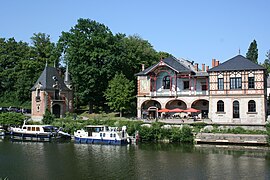Loading AI tools
Sarreguemines
Subprefecture and commune in Grand Est, France From Wikipedia, the free encyclopedia
Sarreguemines (French pronunciation: [saʁɡəmin]; German: Saargemünd [zaːɐ̯ɡəˈmʏnt] , Lorraine Franconian: Saargemìnn) is a commune in the Moselle department of the Grand Est administrative region in north-eastern France.
You can help expand this article with text translated from the corresponding article in French. (December 2008) Click [show] for important translation instructions.
|
Sarreguemines
Saargemünd | |
|---|---|
Subprefecture and commune | |
 View of the Saar River and the casino | |
| Coordinates: 49°07′N 7°04′E | |
| Country | France |
| Region | Grand Est |
| Department | Moselle |
| Arrondissement | Sarreguemines |
| Canton | Sarreguemines |
| Intercommunality | CA Sarreguemines Confluences |
| Government | |
| • Mayor (2020–2026) | Marc Zingraff[1] (DVD) |
| Area 1 | 29.67 km2 (11.46 sq mi) |
| Population (2021)[2] | 20,624 |
| • Density | 700/km2 (1,800/sq mi) |
| Time zone | UTC+01:00 (CET) |
| • Summer (DST) | UTC+02:00 (CEST) |
| INSEE/Postal code | 57631 /57200 |
| Elevation | 192–293 m (630–961 ft) |
| Website | sarreguemines.fr |
| 1 French Land Register data, which excludes lakes, ponds, glaciers > 1 km2 (0.386 sq mi or 247 acres) and river estuaries. | |
It is the seat of an arrondissement and a canton. As of 2020, the town's population was 20,555. The inhabitants of the commune are known as Sarregueminois and Sarregueminoises in French.
Sarreguemines, whose name is a French spelling of the name in local Lorraine-German dialect "Saargemin", meaning "confluence into the Saar", is located at the confluence of the Blies and the Saar, 79 kilometres (49 mi) east of Metz, 107 kilometres (66 mi) northwest of Strasbourg by rail, and at the junction of the lines to Trier and Sarrebourg.[3] Sarreguemines station has rail connections to Strasbourg, Saarbrücken and Metz. Traditionally Sarreguemines was the head of river navigation on the Saar, its importance being a depot where boats were unloaded.
|
| ||||||||||||||||||||||||||||||||||||||||||||||||||||||||||||||||||||||||||||||||||||||||||||||||||||||
| |||||||||||||||||||||||||||||||||||||||||||||||||||||||||||||||||||||||||||||||||||||||||||||||||||||||
| Source: EHESS[4] and INSEE (1968-2017)[5] | |||||||||||||||||||||||||||||||||||||||||||||||||||||||||||||||||||||||||||||||||||||||||||||||||||||||
Sarreguemines was, from 1985 to 2015, the seat of two cantons:
Both cantons, minus the communes of Grundviller, Guebenhouse, Loupershouse and Woustviller that were added to the canton of Sarralbe, were merged into one canton of Sarreguemines on 1 January 2015.
Sarreguemines, originally a Roman settlement, obtained civic rights early in the 13th century. In 1297 it was ceded by the count of Saarbrücken to the Duke of Lorraine, and passed with Lorraine in 1766 to France.[3] French Influence: The fortunes of Sarreguemines took another turn in 1766 when it passed from Lorraine to France. This period saw the town further develop its industries, including the production of plush velvet, leather, faience, porcelain, and papier-mâché boxes, primarily utilized for snuffboxes. Sarreguemines became renowned for its artisanal craftsmanship and artistic traditions.
It was transferred to Germany in 1871, with the Treaty of Frankfurt following the Franco-Prussian War. From 1871 to 1918 it formed part of the German imperial province of Alsace-Lorraine and manufactured plush velvet, leather, faience and porcelain, and was a centre for making papier-mâché boxes, mostly used for snuffboxes.[3] It was returned to France after World War I.
On 21–23 December 1944 the 44th Infantry Division (United States) threw back three attempts by the Germans to cross the Blies River. An aggressive defense of the Sarreguemines area was continued throughout February and most of March 1945.
Sarreguemines was the birthplace of :
Seamless Wikipedia browsing. On steroids.
Every time you click a link to Wikipedia, Wiktionary or Wikiquote in your browser's search results, it will show the modern Wikiwand interface.
Wikiwand extension is a five stars, simple, with minimum permission required to keep your browsing private, safe and transparent.